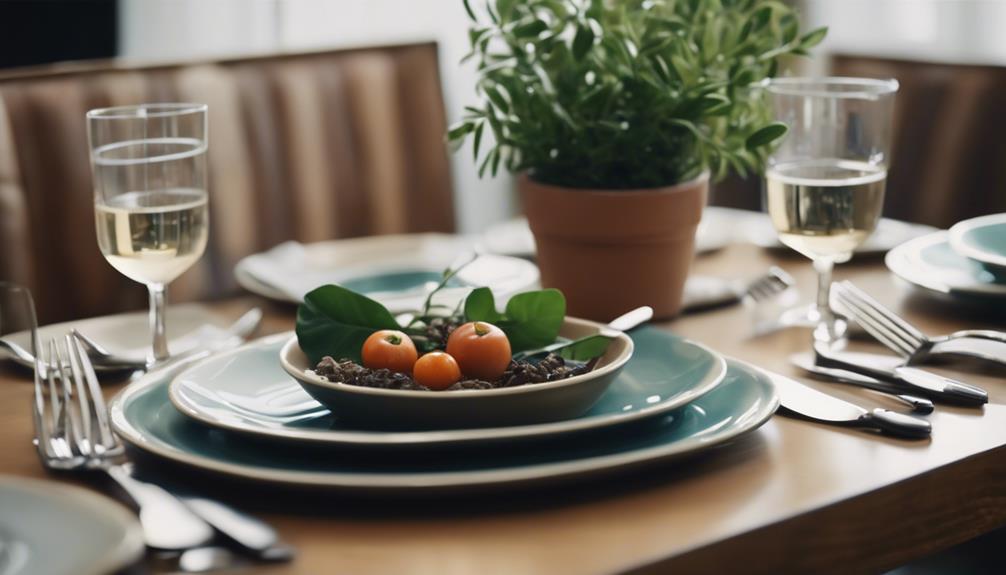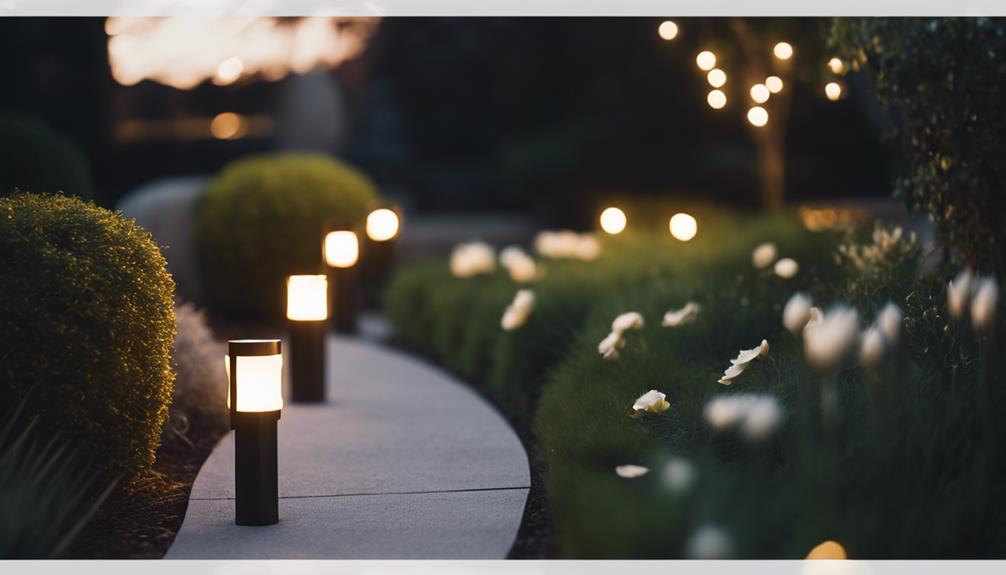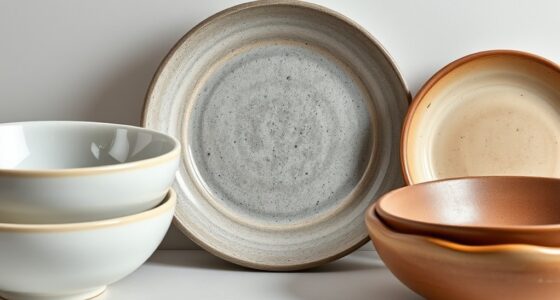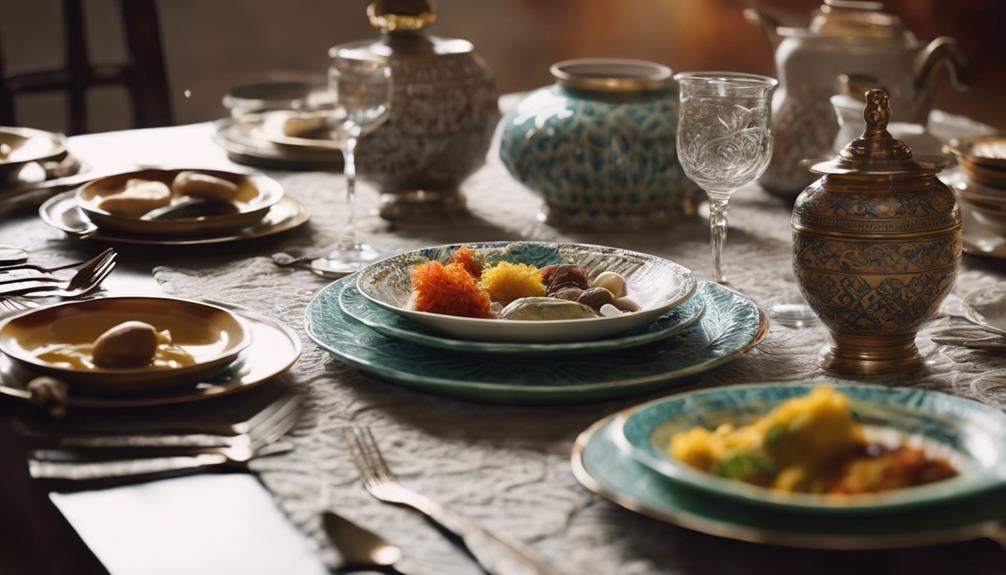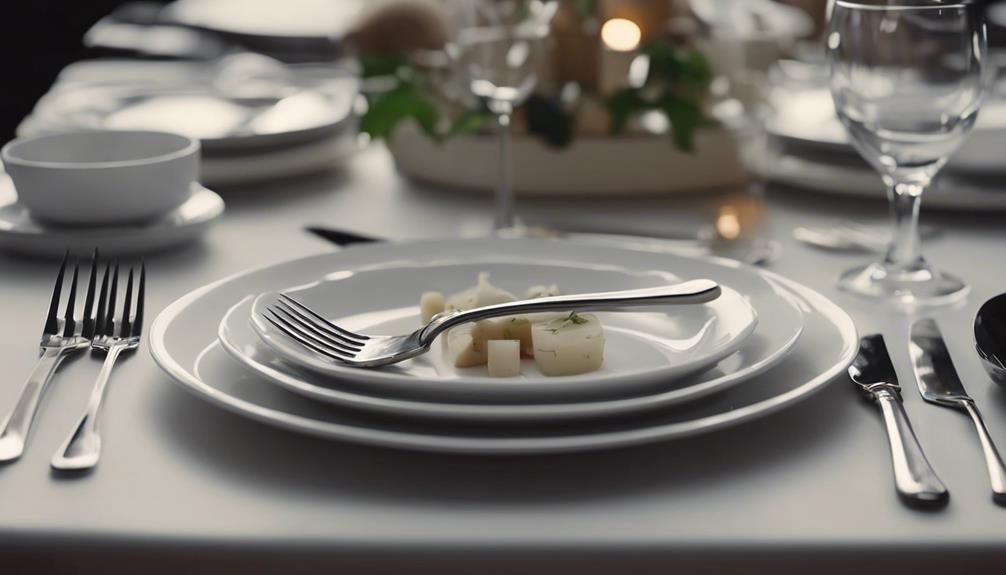When looking at items categorized as tableware, it’s crucial to understand that linens, such as tablecloths and napkins, are not included in this category. Tableware typically consists of chinaware, serveware, dinnerware, silverware, and drinkware, all of which are used for serving and eating food. These pieces, often made from materials like ceramic and porcelain, enhance dining experiences with their size, shape, and design. Recognizing this difference can help you create the right ambiance for your meals. For further insight into the distinctions and significance of tableware in dining, continue to explore additional details about this essential aspect of meal presentation.
Key Takeaways
- Table linens like tablecloths and napkins are not classified as tableware.
- Decorative and protective items for the table.
- Tableware includes items like plates, cutlery, and glasses.
- Tableware serves functional purposes in dining.
- Table linens add style and color to the table setting.
Definition of Tableware
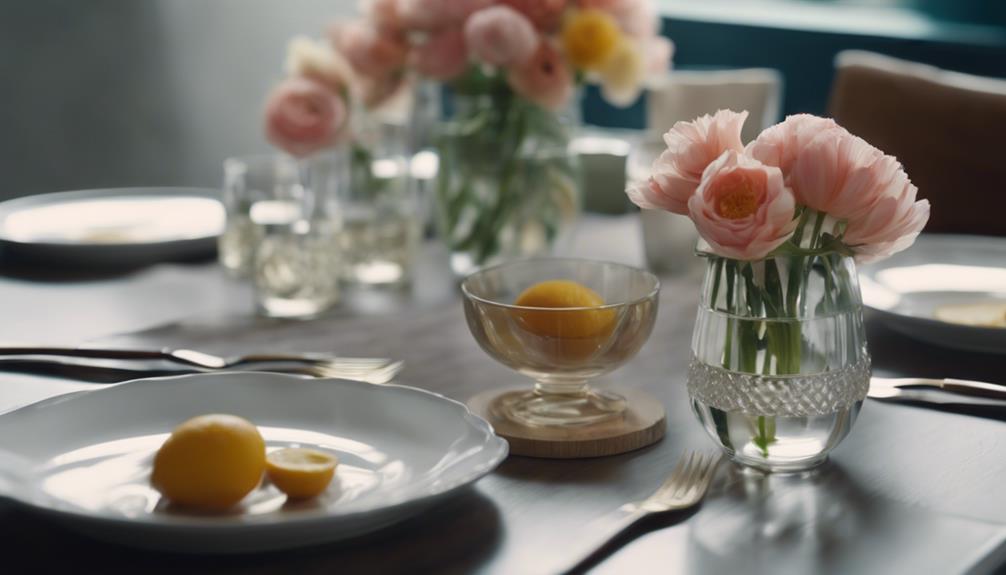
Tableware encompasses a range of items essential for setting the table and dining experience. These items are used for serving and come in different categories.
One of the categories of tableware is known as Chinaware. Chinaware consists of plates, bowls, teacups, and other dishes made from porcelain or bone china. It's prized for its delicate appearance and durability, making it a popular choice for special occasions and formal dining.
In addition to Chinaware, tableware includes serveware, which consists of items used for serving food at the table. This category may include platters, serving bowls, and trays designed to make serving meals easier and more elegant.
Dinnerware is another essential category, used for serving individual portions during a meal. This can include plates, bowls, and even ramekins for sauces or condiments.
Lastly, silverware comprises cutlery items like spoons, forks, and knives, while drinkware includes items like glasses, mugs, and cups for enjoying beverages. Each category plays an important role in enhancing the dining experience.
Types of Tableware Items
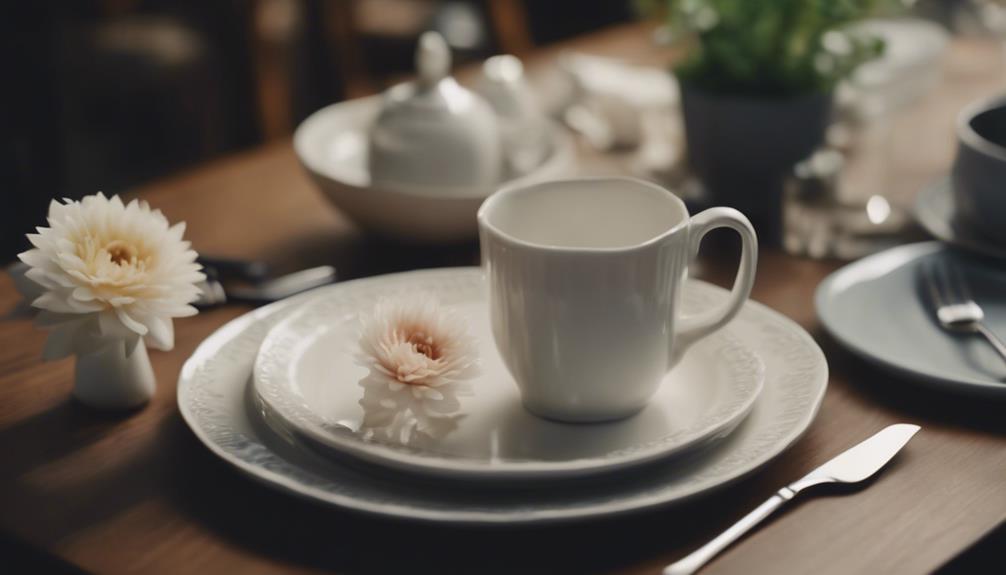
Chinaware, serveware, dinnerware, silverware, and drinkware are all types of tableware items that play specific roles in the dining experience.
- Serving Spoons: Essential for serving dishes like salads, casseroles, and desserts, serving spoons come in various sizes and designs to complement different serving bowls and platters.
- Soup Pots: These specialized pots are perfect for serving soups and stews, keeping them warm throughout the meal, and often feature convenient handles and lids for easy handling and storage.
- Salad Bowls: Ideal for presenting fresh salads, fruit mixes, or pasta salads, salad bowls come in different materials like glass, ceramic, or wood, adding a touch of elegance to your table setting.
Each type of tableware item serves a distinct purpose, enhancing the dining experience by not only providing functionality but also contributing to the overall aesthetic appeal of the meal.
From serving spoons to soup pots and salad bowls, these essential tableware items cater to various culinary needs and presentation styles.
Characteristics of Tableware
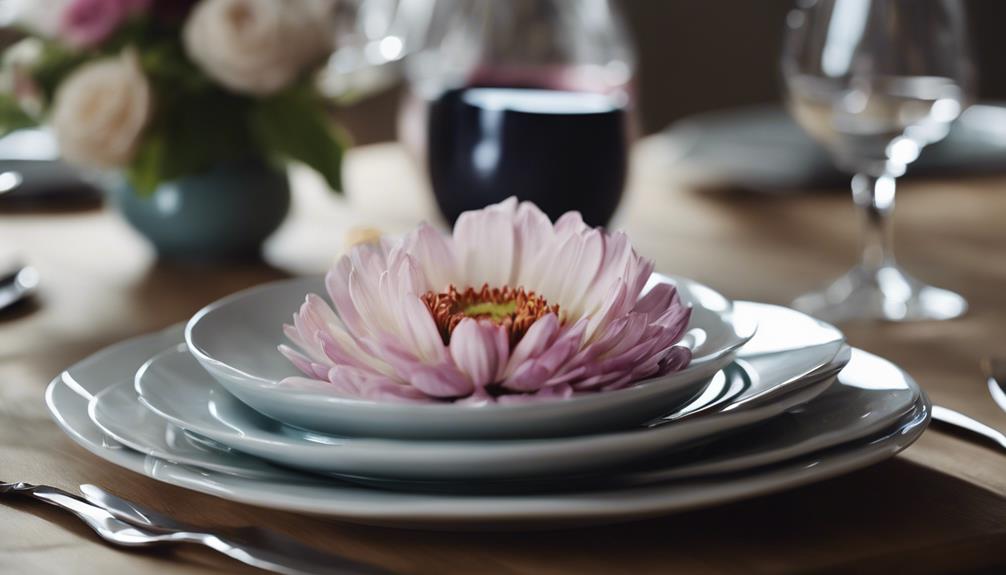
Tableware comes in various types, each serving a specific purpose at the dining table. The materials used in tableware can range from porcelain to stainless steel, adding to the aesthetic and durability of the items.
Functional aspects like size, shape, and design play an important role in how tableware enhances the overall dining experience.
Types of Tableware
What makes certain items essential for enhancing your dining experience? Here are three key types of tableware to take into account:
- Plates: Plates are essential for serving and presenting food in an organized and aesthetically pleasing manner. They come in various shapes, sizes, and designs to suit different dining preferences.
- Forks and Knives: Cutlery, including forks and knives, are vital tools for enjoying a meal. They facilitate the process of cutting, spearing, and conveying food to your mouth efficiently.
- Serving Bowls: Serving bowls are ideal for sharing dishes like salads, pasta, or sides with your dining companions. They add a communal aspect to the dining experience, encouraging interaction and conviviality among guests.
Materials Used
Ceramic, glass, earthenware, porcelain, and stoneware are some of the materials commonly used in tableware, each with unique characteristics that contribute to the dining experience.
Ceramic plates are known for their durability and ability to retain heat, keeping your food warm for longer periods.
Glassware adds an elegant touch to the table setting with its transparent and sophisticated appearance, perfect for formal occasions.
Earthenware brings a rustic and artisanal feel, ideal for serving food in a cozy and traditional setting.
Porcelain plates are delicate and refined, prized for their translucency and elegant look, making them a popular choice for special gatherings.
Stoneware is chip-resistant and versatile, suitable for everyday use, ensuring your tableware lasts through many meals.
Functional Aspects
When thinking about the functional aspects of tableware, it's vital to focus on how these items enhance your dining experience through usability and practicality. Here are three key points to keep in mind:
- Basic Plate: The basic plate is a fundamental piece of tableware that serves as the foundation for serving food. It should be sturdy and of an adequate size to accommodate various dishes.
- Size and Shape: The size and shape of tableware play an important role in how you present food. Different shapes and sizes can enhance the visual appeal of your meals and contribute to an enjoyable dining experience.
- Present Food: Tableware should be designed to present food in an appealing and organized manner, making it easier for you and your guests to enjoy the meal.
Importance of Tableware in Dining
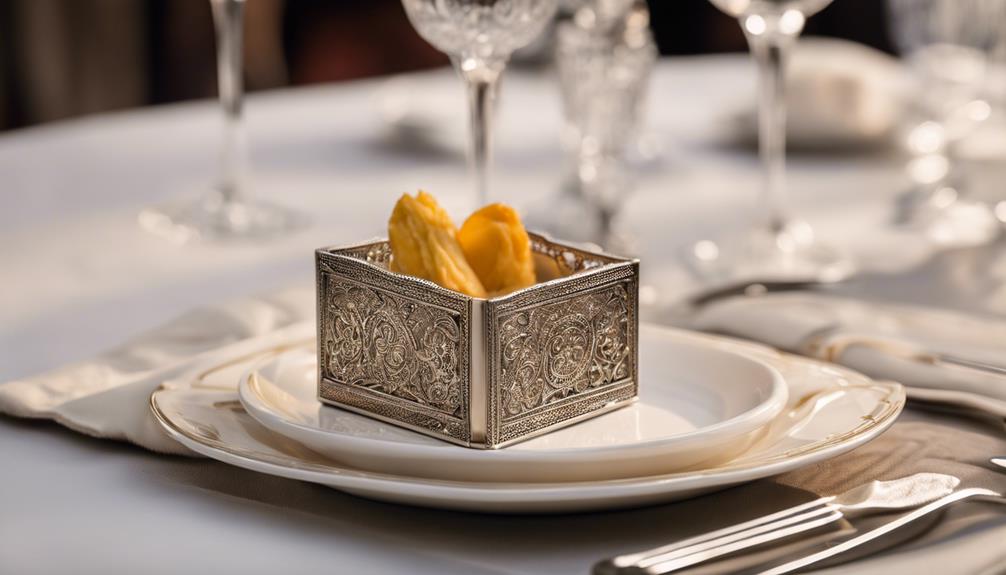
Enhance your dining experience by recognizing the vital role tableware plays in setting the tone and atmosphere of your meal. Plates, serving dishes, and utensils come in different shapes and sizes, each serving a specific purpose in the dining experience. The presentation of food on beautifully crafted plates adds style and elegance to your meals, creating a visually appealing setting that enhances your overall enjoyment.
Choosing the right tableware allows you to reflect your personal taste and preferences, showcasing your unique style to guests. The variety of tableware options available enables you to create a cohesive look for your table, completing the dining setting with sophistication. Whether it's a formal dinner or a casual brunch, the selection of tableware can greatly impact the ambiance and overall dining experience, making it essential to bear in mind the occasion when selecting your tableware. By paying attention to these details, you can elevate your dining experience and impress your guests with a well-thought-out presentation.
Distinction Between Tableware and Table Linens
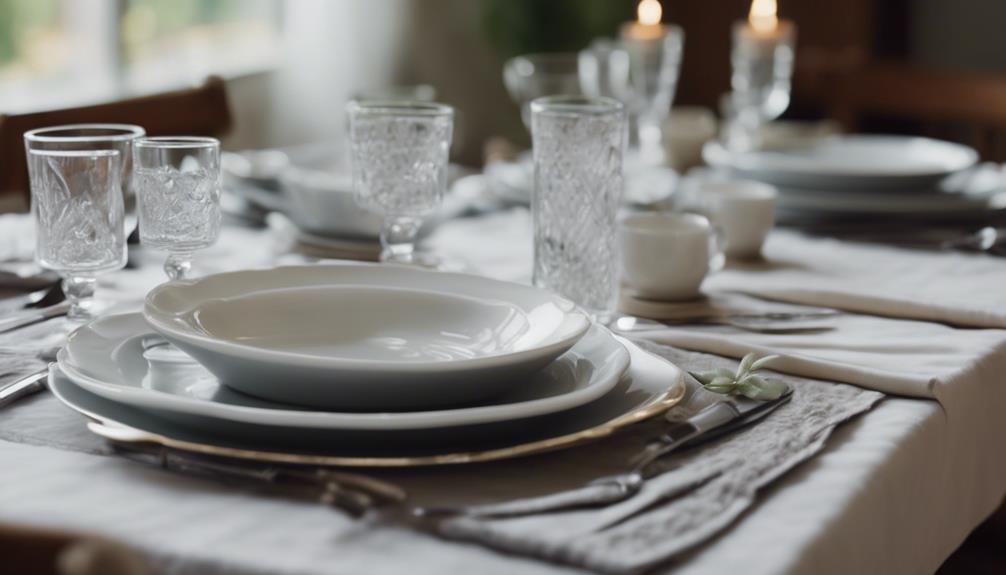
Tableware serves a practical function, facilitating the serving and consumption of food, while table linens are more about decoration and protection.
Tableware, such as plates and utensils, is essential for dining, whereas table linens like tablecloths and napkins add style and color to the dining table.
The distinction between tableware and table linens lies in their purposes – one is functional, while the other is primarily decorative.
Tableware Vs Linens
In the domain of dining aesthetics, the distinction between tableware and table linens is essential for creating a well-appointed table setting. Here are three key differences to help you understand their roles:
- Tableware: This category includes essential items like plates, glasses, and silverware used for serving and enjoying food.
- Table Linens: On the other hand, table linens such as tablecloths, napkins, and placemats serve both decorative and functional purposes in enhancing the dining experience.
- Materials: Tableware is commonly made of ceramic, glass, and stainless steel, while table linens are typically crafted from fabric like cotton, linen, or polyester.
Understanding the distinction between these two elements can elevate your table settings to new levels of sophistication and style.
Purposeful Differences
Moving from the distinction between tableware and table linens, it is important to recognize the purposeful differences that each element brings to a well-appointed dining setting. Below is a comparison table highlighting the key variances between tableware and table linens:
| Aspect | Tableware | Table Linens |
|---|---|---|
| Composition | Plates, bowls, utensils | Cloths, napkins, placemats |
| Function | Essential for serving and eating food | Protecting the table surface, enhancing dining experience |
| Material | Ceramic, glass, stainless steel | Cotton, linen, polyester |
Tableware serves the primary function of food service and consumption, while table linens focus on adding elegance, spill absorption, and protecting the table surface.
Functional Vs Decorative
For a well-appointed dining setting, distinguishing between tableware and table linens is important to understand the functional versus decorative roles each element plays.
3 Key Points:
- Table linens, such as tablecloths, placemats, and napkins, serve as decorative elements for the table setting.
- Tableware, including serveware, dinnerware, flatware, and drinkware, focuses on functional items like plates, utensils, and glasses.
- Table linens play an essential role in enhancing the visual presentation of a table setting, while tableware is crucial for serving and eating food.
Understanding the distinction between tableware and table linens is key to creating a harmonious and visually appealing dining experience.
Common Materials Used for Tableware
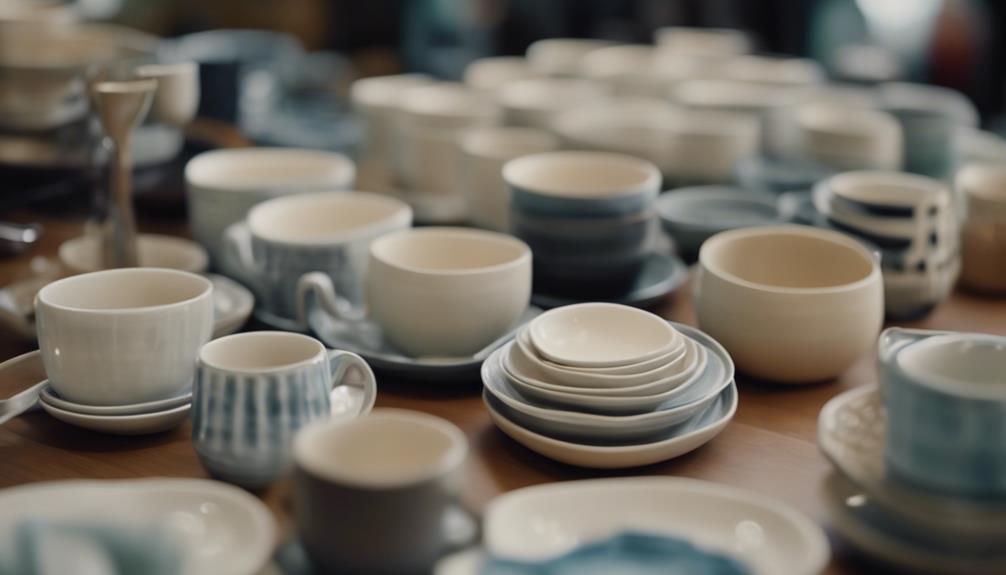
When selecting tableware, consider the common materials like ceramic, glass, earthenware, porcelain, and stoneware for their unique qualities and aesthetics. Ceramic plates are popular for their durability and versatility, making them suitable for everyday use.
Glassware adds elegance to your table setting with its transparent beauty, perfect for special occasions.
Earthenware brings a touch of tradition to your dining experience, known for its rustic and earthy appearance that adds warmth to any meal.
Porcelain is a delicate and refined material, favored for its high quality and sophisticated look on the dining table, ideal for formal settings.
Stoneware is a practical choice, offering durability and resistance to chipping, making it a reliable option for both daily meals and gatherings.
Each material has its own charm and benefits, so choose the one that best fits your style and usage preferences.
Proper Care and Maintenance of Tableware
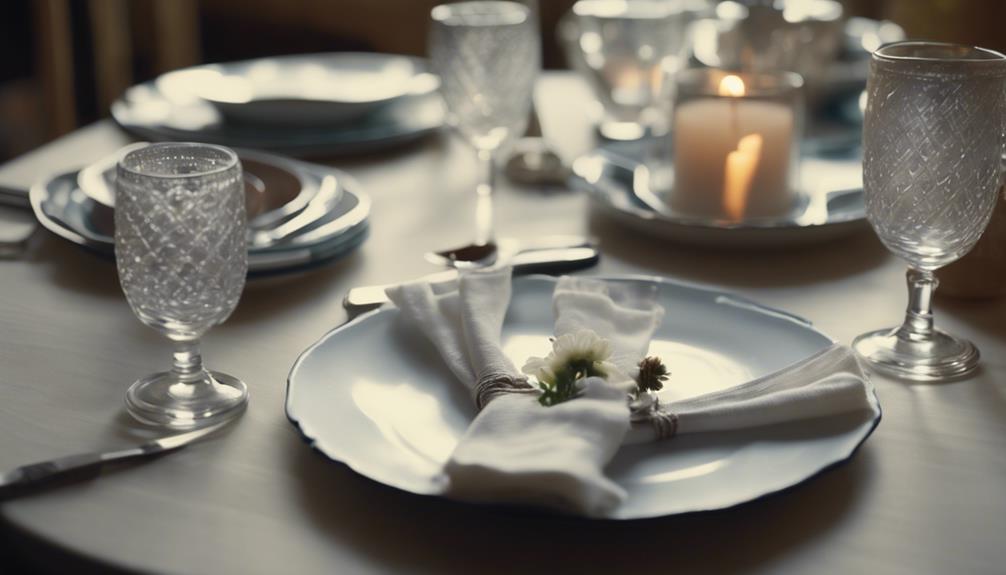
To guarantee your tableware remains in top condition, prioritize proper care and maintenance practices. Here are three essential tips to help you keep your tableware looking its best:
- Hand wash delicate items: Instead of using a dishwasher, opt for hand washing delicate pieces like drinkware or glassware to prevent damage and preserve their quality over time.
- Avoid harsh chemicals: When cleaning your tableware, steer clear of harsh chemicals and abrasive materials that could harm the surface and appearance of your plates and glassware.
- Store carefully: To prevent chipping or breakage, store your tableware with care. Use separators or padding to cushion delicate items like your favorite steak knife and inspect them regularly for any signs of wear or damage. By addressing issues promptly, you can prolong the lifespan of your tableware and enjoy it for years to come.
Frequently Asked Questions
What Are the 4 Classification of Tableware?
The four main classifications of tableware are:
- Serveware, which includes items like serving bowls and platters.
- Dinnerware, consisting of plates and bowls.
- Silverware, comprising cutlery like spoons, forks, and knives.
- Drinkware, including glasses, mugs, and cups for drinking.
These categories cover a wide range of items used for serving and enjoying meals.
What Is Tableware and Examples?
Tableware consists of serveware, dinnerware, silverware, and drinkware. Serveware items include serving bowls and platters.
Dinnerware encompasses plates, bowls, and specialized dinnerware for individual portions.
Silverware consists of spoons, forks, and knives.
Drinkware includes glasses, cups, and mugs for beverages.
These items are essential for setting the table and serving meals. Each type plays a specific role in creating a complete dining experience.
What Are the Basic Tablewares?
When considering basic tableware, you'll typically think of serveware, dinnerware, silverware, and drinkware.
Serveware encompasses items like serving bowls and platters. Dinnerware includes plates and bowls, while silverware consists of cutlery like spoons and forks. Drinkware involves glasses and cups for beverages.
Each type plays an essential role in setting the table for meals, ensuring you have what you need for serving, eating, and drinking.
What Is Considered Dinnerware?
When considering dinnerware, think of plates, bowls, and serving pieces used for individual meal portions. Materials like melamine, porcelain, glass, stoneware, or earthenware are common choices.
Different shapes, colors, and sizes cater to diverse dining preferences. Dinnerware not only presents food attractively but also elevates the dining experience. Your selection may vary based on the courses served and personal style, enhancing the overall meal presentation.
Conclusion
So, to wrap up, when it comes to tableware, plates, glasses, and cutlery are all vital items.
However, a sofa cushion isn't classified as tableware.
It's important to choose the right tableware for your dining needs and to take care of it properly to guarantee it lasts for a long time.
Remember, tableware plays a significant role in enhancing the dining experience and setting the right ambiance for your meals.
